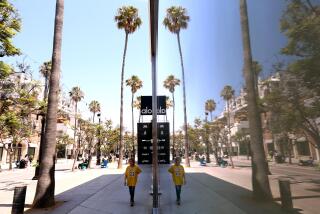Small Towns Vs. Suburbs: Dead-End for Main Street? : Cities: Regional centers struggle to keep downtowns alive as malls, traffic and tracts conquer the countryside.
JACKSONVILLE, Ill. â The changes in this city began about 15 years ago when Morton Avenue was expanded from a two-lane country road into a four-lane expressway with a strip shopping center.
As some businesses moved to the new shopping area, downtown stores began to fail. That led Jacksonvilleâs leading merchants and burghers into a plan to save downtown by turning it into a modern shopping center.
Armed with about $4 million, most of it federal urban renewal funds, they refurbished the water and sewer system, built awnings to protect shoppers from the elements, created parking lots and redirected traffic to make the plaza more pedestrian-friendly.
But despite their best efforts, the deterioration of downtown Jacksonville continued. The outflow of business to Morton Avenue widened into a flood, following a pattern that has been repeated over and over across the nation for many years.
Americaâs historic drive to the suburbs is accelerating dramatically.
Although the phenomenon began in the late 1950s, the steady and relentless push of homeowners, jobs and traffic to the outer limits of urban areas intensified visibly during the 1980s, often transforming communities abruptly, demographers and social scientists say.
The changes, which are warping the social fabric in some communities, are occurring virtually everywhere across the land--even here in Jacksonville, a farming community of 20,000 located 30 miles due west of Springfield, the Illinois state capital.
There no longer is a traditional âMain Streetâ in Jacksonville. Today, the townâs economic muscle is centered on Morton Avenue, a three-mile-long swath on Jacksonvilleâs southern perimeter that has drawn businesses--and people--away from downtown.
âThis is a very uniform phenomenon,â explained Carl Haub, a demographer with the Population Reference Bureau, a division of the Census Bureau.
âAs the center of business has moved away from town and to the suburban areas, so do the people who live around the businesses,â Haub said. âItâs happening, not only in large cities, but in small towns everywhere.â
The most current census figures reveal that 72.1 million people lived in the nationâs suburbs in 1980, up 29.4% from the 55.7 million who counted themselves as suburbanites in 1970. At the same time, small towns lost population, dropping 3.5% to 27.9 million in 1980.
Comparable figures from the 1990 census will not be available for several more weeks but government demographers said they are expected to show that the increasing suburbanization--and its spread to smaller communities--is proceeding at a faster pace.
This is happening in Jacksonville. Preliminary 1990 census data shows 19,257 people were counted in the town earlier this year, down from 20,284 in the 1980 tally. South Jacksonville, an incorporated suburban village, also saw its population decline.
Calvin Beale, an Agriculture Department demographer who is a specialist in small-town America, said that he expects to see the population in suburban Morgan County here rise when the 1990 figures become available. The countyâs population grew, according to the 1980 census.
But the changes are not without some drawbacks.
Jacksonvilleâs leaders are wrestling with a spate of challenges traditionally associated with much bigger cities, including how to maintain a thriving central city that can generate the taxes to support needed human services.
âIâve been in office a year and a half and the question people ask me the most is: âWhat are we going to do about downtown?â â said Ron Tendrick, the cityâs youthful mayor.
The other question they ask in Jacksonville and countless other small towns is how urban decay--usually associated with metropolises such as New York or Los Angeles--could hit a quiet, wholesome place like Jacksonville?
William Severini Kowinski, a Pennsylvania-based writer, believes the answer is that small towns in America no longer are isolated from the pressures smothering bigger cities.
âThe small town is almost impossible to find now,â Kowinski argued in his book, âThe Malling of America.â Nearly everyone in the country now lives in a âNational Hometownâ crafted out of the omnipresence of âtelevision, the highway and the mall,â Kowinski wrote.
Main Street became obsolete ânot only because it was physically bypassed by the highway and its new institutions, but because the new national culture has supplanted the local one with a way of life implied (if not dictated) by consumer products and services,â he said. âWhat they all add up to is that the small town canât be a small town anymore. Itâs a twinkle in the highwayâs eye.â
From the front door of his shoe store on the north side of the downtown plaza, 70-year-old Martin Newman saw the end of downtown coming when Morton Avenue began its expansion into a four-lane expressway.
Newman predicted in the late-1960s that shopping malls were the coming thing. âDowntown is not suited to todayâs shopper,â he said. âEverybody wants to go to the mall because itâs more convenient.â
Newman kept his downtown location--partly, he said, out of loyalty and civic pride--but he hedged his risks by opening branch stores in suburban shopping centers across the southern end of Illinois. âWe knew it was the only way to grow,â he said.
Many of his colleagues and competitors were not as prescient. Although some fled immediately to the strip shopping center on Morton Avenue, a smattering of âsurvivorsâ placed their bets on the ambitious urban renewal effort that eventually failed.
âThe idea was to create a mall or plaza area for public events,â said Tendrick. But the idea did not work.
A recent afternoon visit to the plaza area found few shoppers, plenty of parking spaces and a handful of empty storefronts. Nearly everyone here acknowledges that the revitalization effort has failed.
âIt was an absolute waste of money,â griped Harold Cox, executive vice president of Farmers State Bank & Trust Co. and president of Tri-County Community Development Corp. âIf we had our money back weâd be in a lot better shape today.â
Jacksonvilleâs elected officials and business leaders are hoping that they will have yet another chance to save their downtown.
The John Deere Life Insurance Co., which employs some 200 people in two downtown offices, has offered to double its operations in the plaza area by expanding a casualty insurance operation that would employ up to 120 people.
But there is a catch: The company will only make the commitment if other firms agree to join in.
And, ironically, if the plan ever works, the old central business district will have lost the fight against Morton Avenue. The heart of Jacksonville will have made peace with itself by becoming a service-oriented office park.
âJohn Deere is saying to the community that we want to do all we can to save downtown,â said Ralph Gonzalez, vice chairman of John Deere Life Insurance Co. and vice president of the Jacksonville Area Industrial Corp., a private business development organization.
âWeâd like to see downtown develop with a variety of businesses, office buildings and some specialty retailers. If we do what we want . . . that may be a reason for other businesses to come back to downtown.â Otherwise, he cautioned, âDowntown could die.â
Tendrick, the mayor, is hopeful. âI see an opportunity,â he said of the John Deere proposal. âIt gives us an opportunity to maintain a viable downtown. It will stretch us to make it work. But we are at a crossroads with downtown.â
More to Read
Sign up for Essential California
The most important California stories and recommendations in your inbox every morning.
You may occasionally receive promotional content from the Los Angeles Times.










